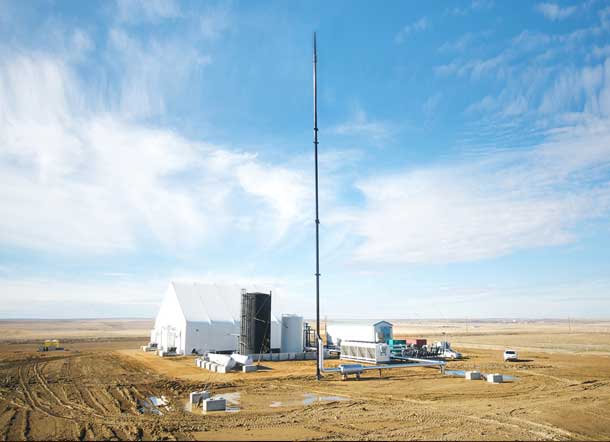What do party balloons, MRI machines and rocket fuel have in common? Helium is a crucial ingredient for each.
There’s growing optimism in Saskatchewan that exploration and production of the ultra light gas could increase here, even more than it has already. The province issued 59 helium leases in 2016; it didn’t issue any the year before.
“The potential is here, definitely,” said Melinda Yurkowski, P.Geo., who has studied the geology of the helium deposits in southwest Saskatchewan. Yurkowski is the Assistant Chief Geologist, Petroleum Geology Unit, with the Saskatchewan Geological Survey at the Saskatchewan Ministry of the Economy.
But helium has some maturing to do if it wants to catch up to the marquee performers in the Saskatchewan resource economy.
Oil, potash and uranium have long been highly sought after commodities. Helium is now considered a marketable product, though its future on the trading front is relatively unknown.
Explorers from across Canada and the United States, as well as the United Kingdom, have expressed interest in Saskatchewan’s helium potential. With the world using approximately eight billion cubic feet of helium every year, there’s a window of opportunity in which Saskatchewan can manoeuver.
Whether helium is the next big star for the province’s economy remains to be seen. Yurkowski sees that market gaining momentum.
“There’s a lot more exploration now than there was five years ago but it’s still in its infancy,” she explained. “I can’t really say where it’s going to lead. It really depends on the quality of the deposits that the explorations are going to find.”
Helium is found both in trace amounts as a byproduct of other gases (such as natural gas) and as a primary commodity. Saskatchewan’s current helium wells, with concentrations between one and two per cent, are considered primary commodity wells.
Saskatchewan’s known helium reserves are found beneath the southwestern part of the province where the gas is trapped in the Deadwood Formation, a 500-million-year-old sandstone unit resting on rocks of the ancient Precambrian shield 2,000 metres below the earth’s surface. The helium is a by-product of the natural decay of uranium and thorium which is found in the Precambrian granitic rocks. As the helium is generated, it escapes the Precambrian through faults and fractures and slowly makes its way to the rocks that can trap the helium.
Right now, production is from the Deadwood, but Yurkowski noted that the potential also exists for other formations in the lower part of the stratigraphic column to trap helium.
The exploration process is similar to that for oil and gas. A drilling rig is used to find the source and once it’s found, the well is cased.
When it comes to producing helium, it needs to be separated from the other gases that are present within the well. Because helium has a lower boiling point than other gases, it is extracted by slowly lowering its temperature. As the temperature decreases, other gases are released from the solution. What remains is helium, though it has to be purified further if you want to develop a medical grade helium.
Weil Group Resources, a helium processing firm, last year revived a couple of dormant natural gas wells that were drilled in the 1950s and 1960s near Mankota, approximately 150 kilometres southeast of Swift Current. Inert gas was present in these wells and helium was found. The facility has the capacity to produce 40 million cubic feet of helium a year — a fraction of the estimated six billion cubic feet the world uses annually.
In addition to these two wells, a third producing well in Saskatchewan is found near Wilhelm – slightly north of Swift Current. Other wells have recently been drilled near Battle Creek near the Alberta border and Simmie, which is slightly southeast of Gull Lake.
Saskatchewan has been home to helium exploration as early as the 1950s. As some would call it, luck played a role in the original discovery of helium in Saskatchewan as geologists learned about the potential for helium while searching for oil and gas in the late 1950s and 1960s.
The discovery of the helium resulted in steady production in Saskatchewan from 1963 to 1977. However, when the price of helium dropped, well producers quietly shut the doors and walked away. Now, with the price of helium rising, these old wells have been rediscovered.
On its website, Helium One says, “the global helium market is expected to exceed $6 billion in 2016. The price of bulk liquid helium has risen more than 100 per cent in the last 10 years.”
Canada has the fifth- or sixth-largest helium resource in the world, behind the U.S., Qatar, Algeria, Russia and possibly Tanzania
Of course, helium’s most popular link is through party balloons and when inhaled allow a person’s voice to reach much higher octaves. Because it’s a lifting gas, it was sought after during World War I thanks to its ability to put blimps in flight.
But helium now serves many valuable uses in the science and technology industry. One of the big uses right now is for a cooling gas for magnetic resonance imaging machines. Because helium is a small molecule and not reactive, you can use it in the manufacturing of semiconductor chips and fibre optic cables, as well as for welding projects and in rocket fuel.
What effect further helium production in Saskatchewan would have on the economy is unknown. But the opportunity is there should additional exploration happen.
“I’m really hoping someone will take a look at that and say that we need to start exploring for helium here, here and here,” Yurkowski said. “But that’s all dependent on the exploration and the developers. But I know there’s a lot of potential here for further helium production.”
